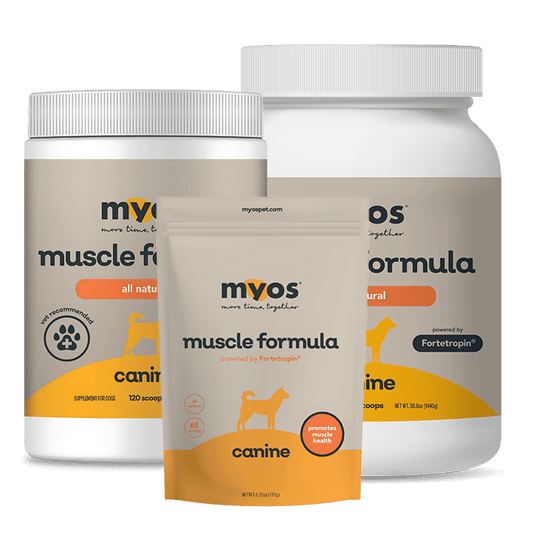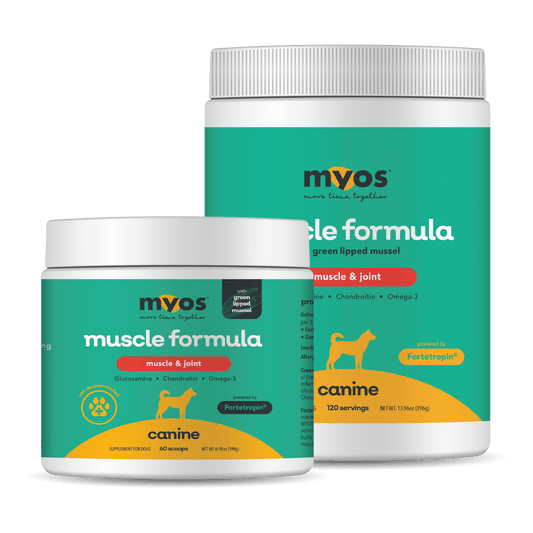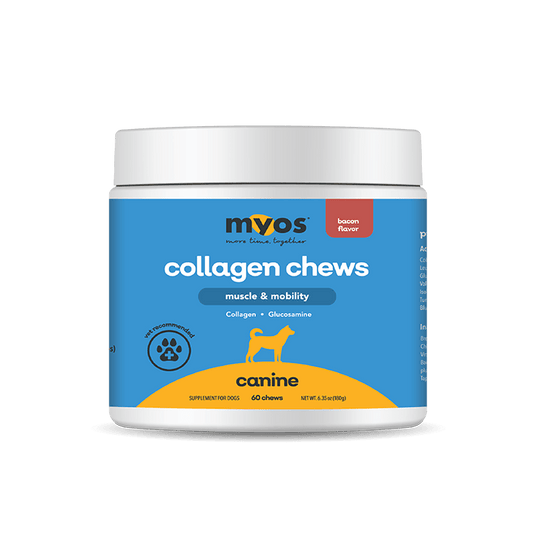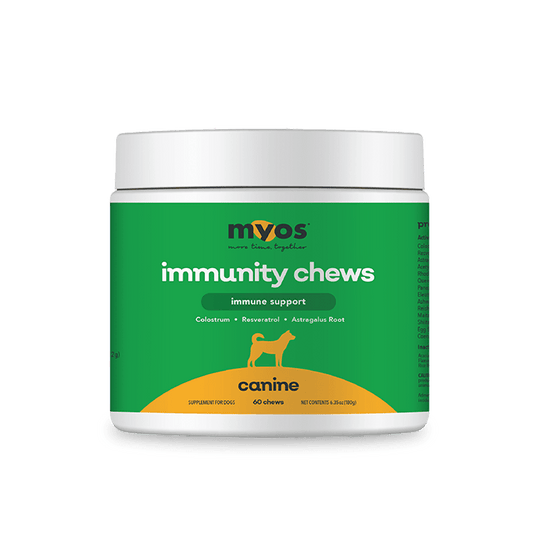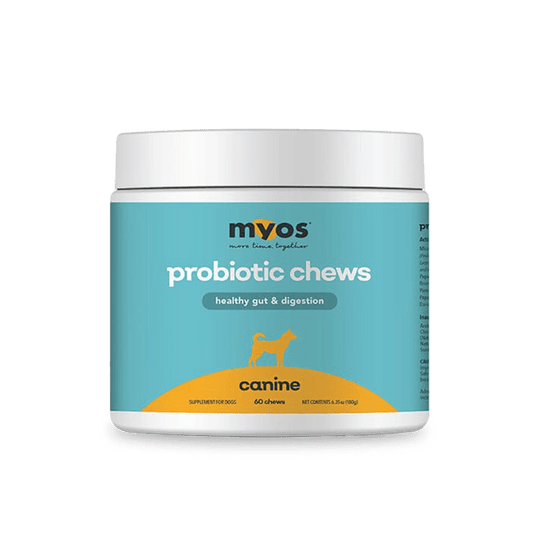Introduction
A common form of age-related muscle loss known as sarcopenia impacts man and man’s best friend in a multitude of different ways. In Veterinary Medicine, one of the first important insights into canine sarcopenia came from a study that was published by Lawler and colleagues at Nestle Research Center and the University of Pennsylvania in 2008 [1] that examined the impact of diet restriction on two groups of Labrador retriever dogs that were paired at 6 weeks of age and followed for two decades. Both groups of dogs received a diet that was identical in composition while the restricted group (unshaded circles) received 25% fewer calories on a daily basis relative to the control group (shaded circles). Although dogs in the study maintained a relatively constant weight from 3-12 years of age, a decline in lean body mass begins once dogs reach about 6 years of age. This loss of lean body mass is compensated by an increase in fat mass.

Figure 1: The impact of diet restriction on body weight, fat body mass, body condition score and lean body mass. Reproduced from [1].
As muscle mass and strength declines, this naturally leads to a decline in physical performance [2]. Naturally, this decline in the physical performance of dogs as they age and lose muscle is of great concern to veterinarians that care for working dogs and sporting dogs on a daily basis. However, reduced physical performance makes it difficult for dogs and their owners to participate in a simple activity that gives both great pleasure while enhancing the quality of their lives: walking. Yet, sarcopenia has implications that go well beyond maintaining quality of life. A number of studies have reported that an increased in mortality rate results when man [3-4] and man’s best friend [5] lose muscle mass. In this blog post, we will discuss some of the key studies that examined the impact of muscle loss on longevity and quality of life in both dogs and cats.
The Impact of the Frailty Related Phenotype on Mortality Rate in Dogs
Researchers at the École nationale vétérinaire d'Alfort (ENVA), France developed a phenotype comprised of five components to describe frailty in dogs. Sarcopenia is regarded as one of the main causes of frailty [6]. Hua and co-workers [5] coined the term, “frailty related phenotype” (FRP) and described five components that comprise the FRP:
- Chronic Undernutrition
- Exhaustion
- Low Physical Activity Level
- Poor Mobility
- Weakness
Hua et al. were interested in testing the hypothesis that dogs that exhibited 2 or more of the FRP components listed above had a great risk of mortality when compared with dogs that exhibited either 0 or 1 FRP component. To test this hypothesis, the researchers conducted a veterinary clinical trial that involved 116 aged, neutered guide dogs (58 males, 58 females) obtained from the Parisian School of Guide Dogs for Blind or Visually Impaired People. The dogs (Golden Retriever, Labrador Retriever and Golden Retriever-Labrador Retriever crossbreeds) were followed after undergoing a clinical geriatric assessment (CGA). It is clear from Figure 2 that dogs that exhibited 2 or more FRP components at the time of their CGA had a much greater mortality rate in comparison to dogs that exhibited only 0 or 1 FRP component at the time of their CGA. Because muscle loss is one of the major causes of frailty, this study suggests that improvements in muscle health are directly correlated with improved life span in dogs.

Figure 2: A Kaplan-Meier estimate of time to death after CGA. The solid line represents dogs with 0 of 1 FRP components at the time of the CGA. The dashed line represents dogs ≥ 2 FRP components at the time of the CGA. Reproduced from [5].
The Impact of Body Condition Score on Survival in Dogs with Chronic Heart Failure
Researchers at Tufts University College of Veterinary Medicine were interested in determining whether the body condition score at the time that dogs were diagnosed with chronic heart failure along with the changes in body weight that they experienced after diagnosis could predict survival [7]. Slupe and co-workers reviewed medical records from 108 dogs with chronic heart failure (International Small Animal Cardiac Health Council stages 2, 3a, or 3b) that was secondary to dilated cardiomyopathy or chronic valvular disease. It is clear from Figure 3 that dogs that suffered from severe muscle wasting (emaciated) at the time that they were diagnosed with chronic heart failure experienced the poorest survival. However, one trend that was quite surprising was the fact that the dogs that were overweight had an improved survival rate following a chronic heart failure diagnosis when compared with the dogs that were underweight and that had an ideal weight. This brings us to a phenomenon known as the obesity paradox. In both Human and Veterinary Medicine, obesity is associated with a higher incidence of certain diseases such as chronic heart failure and chronic kidney disease. What is paradoxical is the fact that upon actually being diagnosed with chronic heart failure, it appeared that obesity appeared to provide some cardiac protection which dogs in the other weight categories (underweight, ideal weight) did not benefit from. According to the authors, “The obesity paradox is a relatively newly addressed phenomenon in cardiology, with the first paper from human medicine being published in 2001. There are a number of possible reasons that the obesity paradox may exist, and it is not yet clear whether this is just an association or whether a causal relationship exists. One possible explanation may be a cardioprotective role of adipose tissue‐derived neuroendocrine molecules, including cytokines and hormones.” Another example from Veterinary Medicine in which the obesity paradox was observed was in cats that were diagnosed with chronic kidney disease [8].

Figure 3: The impact of body condition on dogs diagnosed with chronic heart failure. Reproduced from [7].
The Impact of Sarcopenia on Cats Diagnosed with Chronic Kidney Disease
To gain insight into weight loss in cats diagnosed with chronic kidney disease (CKD), veterinarians recruited 569 cats (55.5% females and 44.5% males) with CKD from 6 US veterinary practices. As illustrated in Figure 4a, cats began to lose weight 3 years prior to the diagnosis of CKD. Upon diagnosis with CKD, the cats that participated in the clinical trial experienced an acceleration in weight loss. Figure 4b illustrates that cats with sarcopenia that are later diagnosed with CKD have much poorer odds of survival relative to non-sarcopenic cats. The average weight of an adult cat is between 5 to 6 kilograms. A cat with a body weight of 3 kilograms had a hazard ratio that was ~2.5-times greater than the hazard ratio of a 5 kilogram cat (Figure 4b). A cat that had a body weight of 7 kilograms actually had a lower hazard ratio than that of a 5 kilogram cat. Further, an obese cat with a body weight of 8 kilograms actually had a hazard ratio that was very similar to that of a 5 kilogram cat. This observation suggests that the phenomenon of the obesity paradox was also observed in cats with CKD as it was observed in dogs with CHF [7]. Although obesity is associated with a greater risk of CKD [9], once a cat was actually diagnosed with CKD, there appeared to be a protective effect due to the obesity. This study suggests that by taking proactive steps to address sarcopenia, veterinarians can help cats diagnosed with CKD survive longer.

Figure 4: (a) The change in body weight in cats diagnosed with chronic kidney disease. (b) Hazard ratio for cats diagnosed with chronic kidney disease based on their body weight at the time of diagnosis. Reproduced from [8].
Addressing Muscle Loss in Cats and Dogs: Nutrition and Pharmaceutical Studies
The good news related to muscle loss in cats and dogs is that considerable progress has been made in Veterinary Medicine over the past decade in terms of addressing small animal sarcopenia. When small animals are placed on weight loss programs to address obesity, there is typically a significant degree of muscle loss that results during the process. Vitger and colleagues [10] at the University of Copenhagen incorporated a fitness program for dogs that were on a weight loss management program. Their fitness program included underwater and land-based treadmill exercise thrice per week. Vitger et al. reported that inclusion of the fitness program was effective in terms of preventing muscle loss in overweight dogs undergoing a weight loss regimen.
In Human Medicine, it is well understood that older adults require a higher recommended daily allowance (RDA) of protein relative to younger adults in order to preserve muscle mass [11]. Similar trends have also been noted in Veterinary Medicine [12] as it is widely accepted that older dogs require an RDA of protein that is ~50% higher relative to young dogs to maintain their muscle mass [13]. Because inflammation plays an important role in muscle atrophy, sources of omega-3 fatty acids such as fish oil [14] and krill oil [15] have been shown to attenuate muscle loss in dogs. Fortetropin, a fertilized chicken egg yolk-derived nutrition product has been shown to attenuate muscle loss in dogs recovering from TPLO surgery [16]. The FDA-approved drug, capromorelin acts as a ghrelin mimetic and has been successfully used for appetite stimulation in dogs [17] and cats [18], acting to reduce muscle atrophy.
Summary
In Veterinary Medicine, numerous studies involving both dogs and cats shown that muscle loss is associated with reduced longevity, particularly when animals are suffering from underlying illnesses such as chronic heart failure and chronic kidney disease. Including a fitness program as part of a weight loss program has been shown to reduce muscle loss. Senior dogs need an RDA of protein that is ~50% higher than the RDA of protein for younger dogs. Further, nutritional supplements such as fish oil, krill oil, Fortetropin and drugs such as capromorelin have been shown to attenuate muscle loss in clinical trials.
References
- Lawler, Dennis F., et al. "Diet restriction and ageing in the dog: major observations over two decades." British Journal of Nutrition99.4 (2008): 793-805.
- Fielding, Roger A., et al. "Sarcopenia: an undiagnosed condition in older adults. Current consensus definition: prevalence, etiology, and consequences. International working group on sarcopenia." Journal of the American Medical Directors Association12.4 (2011): 249-256.
- Ruiz, Jonatan R., et al. "Association between muscular strength and mortality in men: prospective cohort study." Bmj337 (2008).
- Caan, Bette J., et al. "Association of muscle and adiposity measured by computed tomography with survival in patients with nonmetastatic breast cancer." JAMA oncology4.6 (2018): 798-804.
- Hua, J., Hoummady, S., Muller, C., Pouchelon, J. L., Blondot, M., Gilbert, C., & Desquilbet, L. (2016). Assessment of frailty in aged dogs. American journal of veterinary research, 77(12), 1357-1365.
- Roubenoff, R. "Sarcopenia: a major modifiable cause of frailty in the elderly." The journal of nutrition, health & aging4.3 (2000): 140-142.
- Slupe, J. L., L. M. Freeman, and J. E. Rush. "Association of body weight and body condition with survival in dogs with heart failure." Journal of veterinary internal medicine22.3 (2008): 561-565.
- Freeman, L. M., et al. "Evaluation of weight loss over time in cats with chronic kidney disease." Journal of veterinary internal medicine30.5 (2016): 1661-1666.
- Ritz, Eberhard. "Obesity and CKD: how to assess the risk?." American Journal of Kidney Diseases52.1 (2008): 1-6.
- Vitger, Anne D., et al. "Integration of a physical training program in a weight loss plan for overweight pet dogs." Journal of the American Veterinary Medical Association248.2 (2016): 174-182.
- Phillips, Stuart M., Stéphanie Chevalier, and Heather J. Leidy. "Protein “requirements” beyond the RDA: implications for optimizing health." Applied Physiology, Nutrition, and Metabolism41.5 (2016): 565-572.
- Laflamme, Dottie. "Effect of diet on loss and preservation of lean body mass in aging dogs and cats." In: Companion animal nutrition summit. Charleston (SC): Purina Institute(2018): 41-46.
- Wannemacher Jr, R. W., and John R. McCoy. "Determination of optimal dietary protein requirements of young and old dogs." The Journal of nutrition88.1 (1966): 66-74.
- Freeman, Lisa M., et al. "Nutritional alterations and the effect of fish oil supplementation in dogs with heart failure." Journal of Veterinary Internal Medicine12.6 (1998): 440-448.
- Burri, Lena, et al. "Effects of dietary supplementation with krill meal on serum pro-inflammatory markers after the iditarod sled dog race." Research in veterinary science 121 (2018): 18-22.
- White, Dana A., et al. "Fortetropin inhibits disuse muscle atrophy in dogs after tibial plateau leveling osteotomy." Plos one15.4 (2020): e0231306.
- Rhodes, Linda, et al. "Capromorelin: a ghrelin receptor agonist and novel therapy for stimulation of appetite in dogs." Veterinary medicine and science4.1 (2018): 3-16.
- Wofford, J. A., et al. "Evaluation of the safety of daily administration of capromorelin in cats." Journal of veterinary pharmacology and therapeutics41.2 (2018): 324-333.

